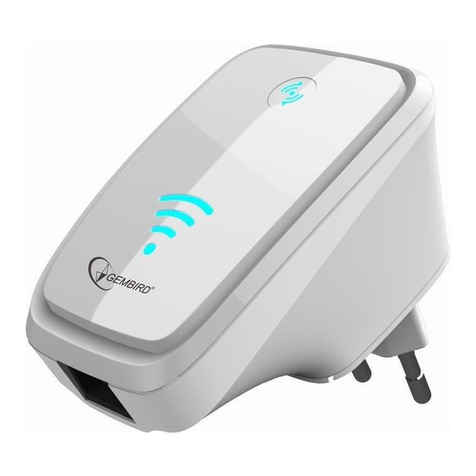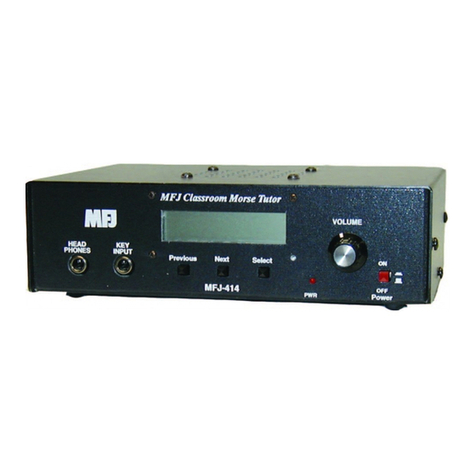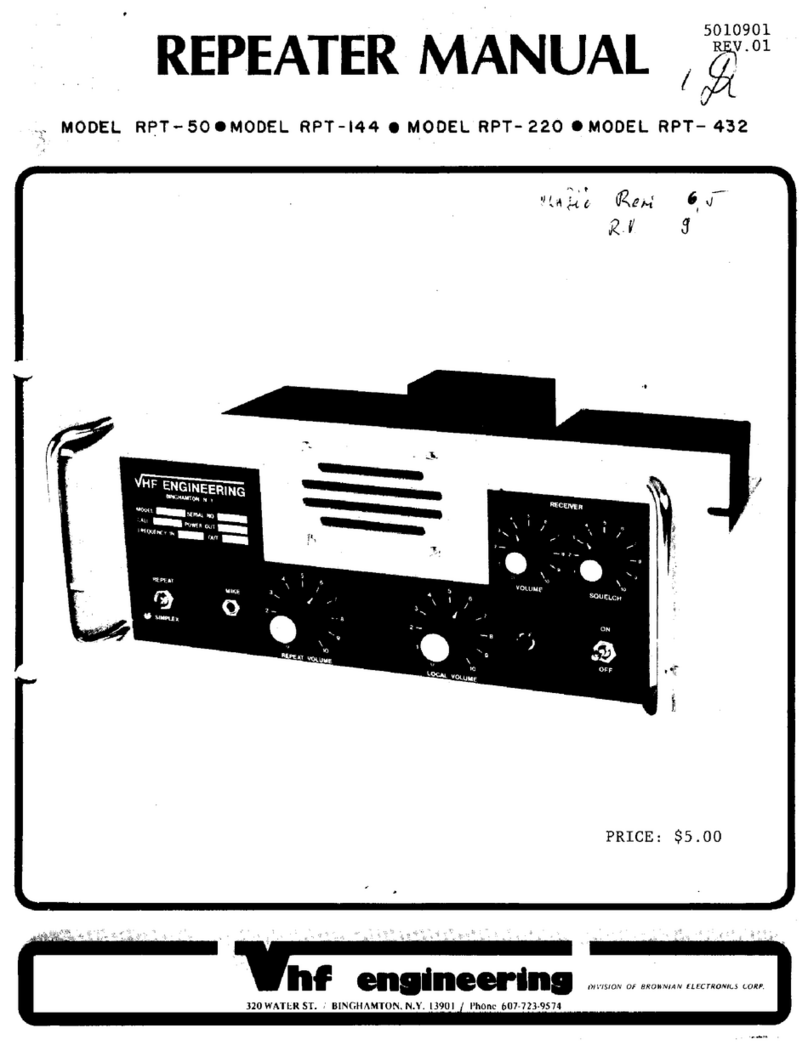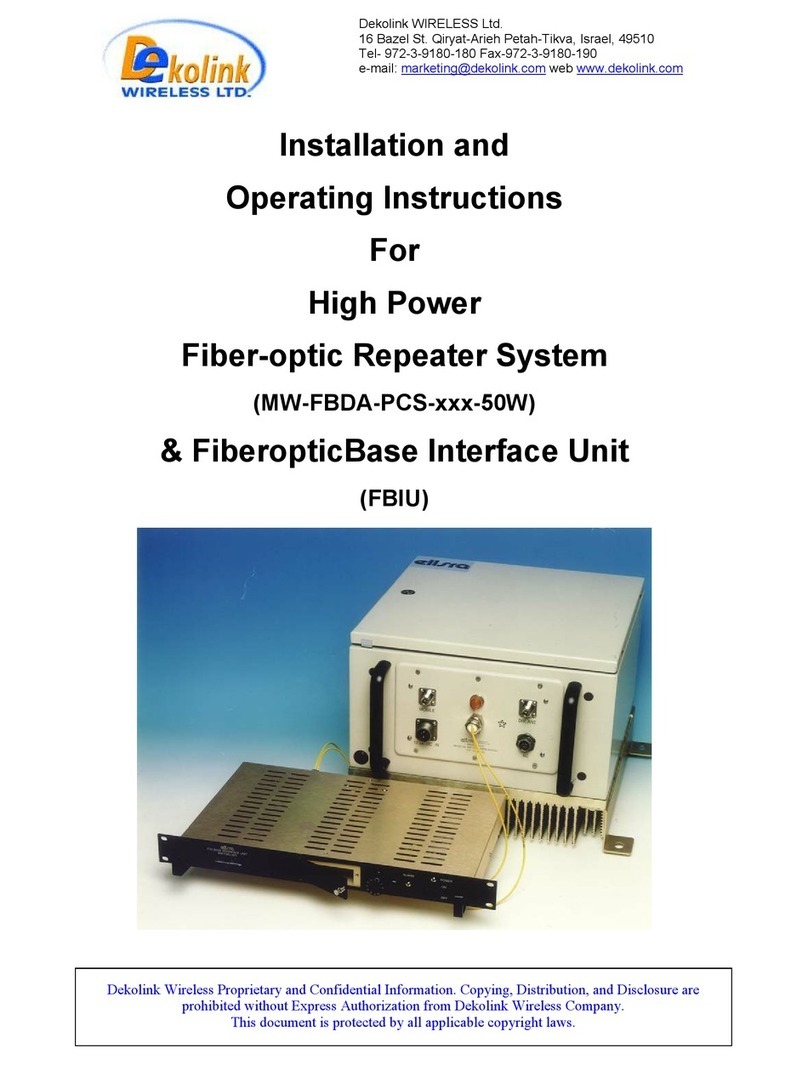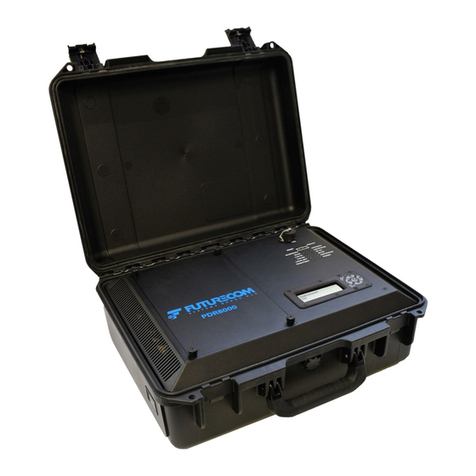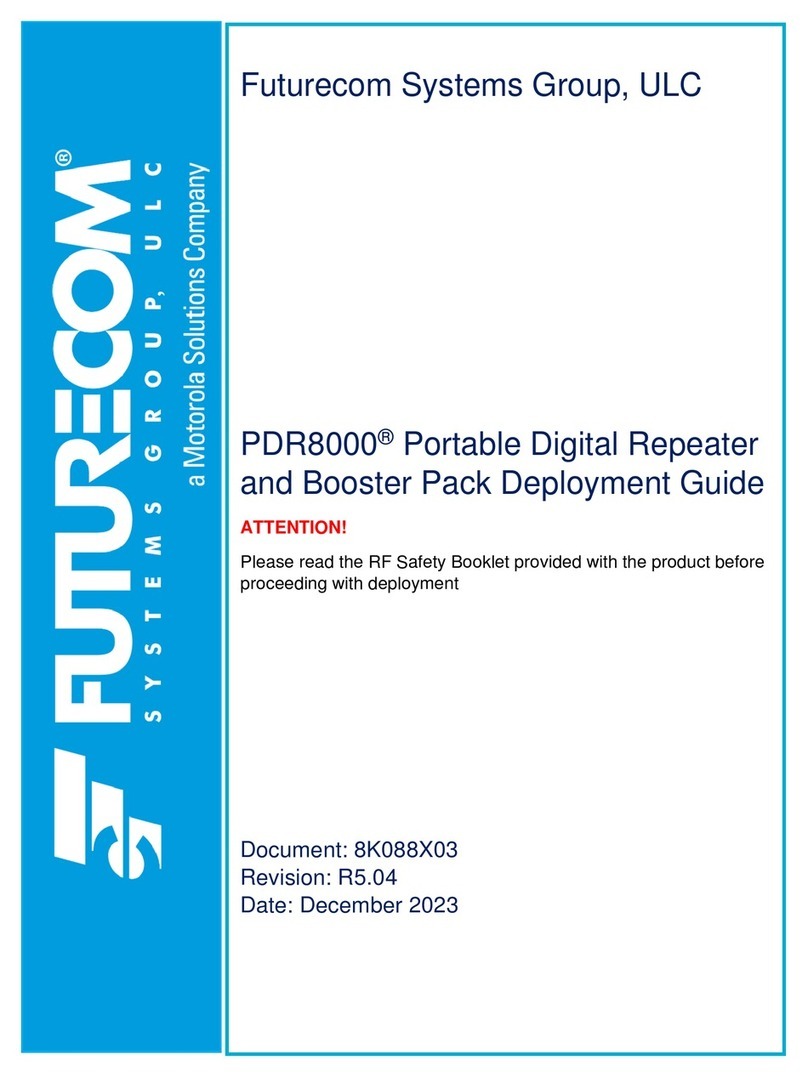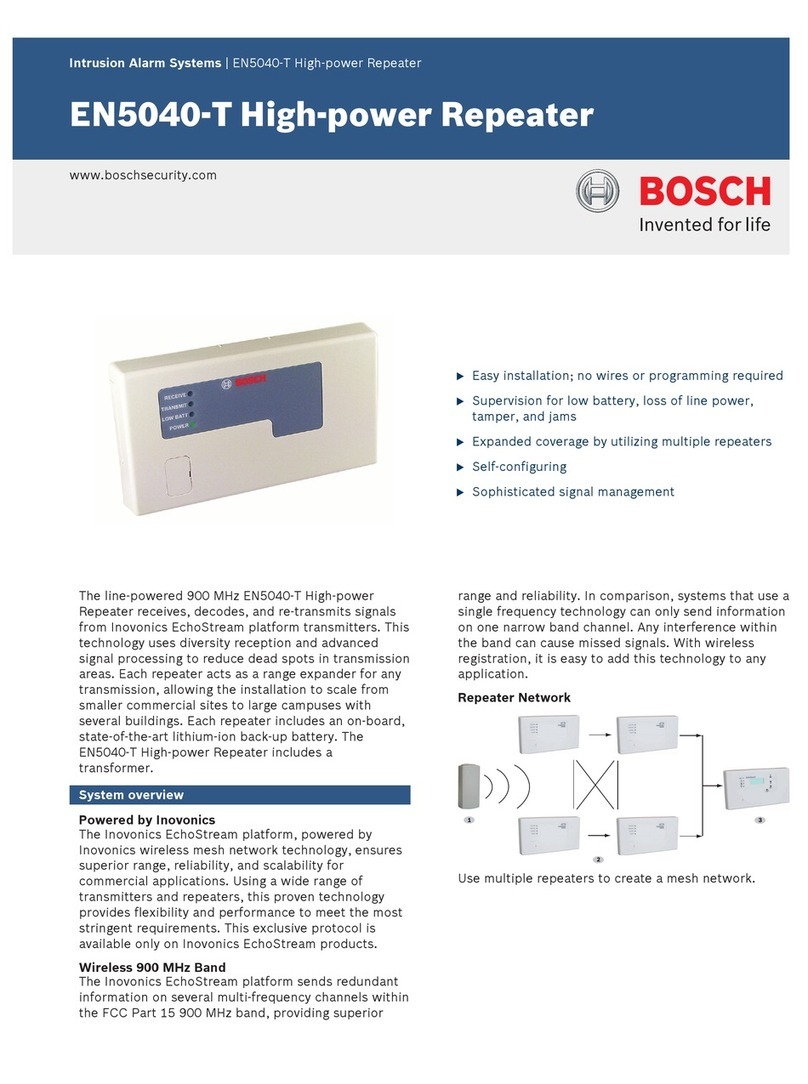GM International D1014S Instruction Manual

D1014 - SIL 2 Repeater Power Supply Hart compatible ISM0052-16
D1014S - D1014D
INSTRUCTION & SAFETY MANUAL
SIL 2 Repeater Power Supply
Hart compatible
DIN-Rail Models D1014S, D1014D

D1014 - SIL 2 Repeater Power Supply Hart compatible G.M. International ISM0052-16
2
General Description: The single and dual channel DIN Rail Repeater Power Supply, D1014S and D1014D is a high integrity analog input interface suitable for applications requiring
SIL 2 level (according to IEC61508:2010 Ed. 2) in safety related system for high risk industries. Provides a fully floating dc supply for energizing conventional 2 wires 4-20 mA
transmitters located in Hazardous Area, and repeats the current in floating circuit to drive a Safe Area load. The circuit allows bi-directional communication signals, for Hart transmitters.
Function: 1 or 2 totally independent and isolated channels I.S. analog input for 2 wires loop powered Hart transmitters, provides 3 port isolation (input/output/supply) and current
(source or sink) or voltage output signal.
Signalling LED: Power supply indication (green).
Field Configurability: mA (source or sink) or V output signal.
Hart Communication Frequency Band: 0.5 to 2.5 KHz within 3 dB.
EMC: Fully compliant with CE marking applicable requirements.
Functional Safety Management Certification:
G.M. International is certified by TUV to conform to IEC61508:2010 part 1 clauses 5-6 for safety related systems up to and included SIL3.
Supply: 12-24 Vdc nom (10 to 30 Vdc) reverse polarity protected, ripple within voltage limits 5 Vpp.
Current consumption @ 24 V: 110 mA for 2 channels D1014D, 55 mA for 1 channel D1014S with 20 mA output typical.
Current consumption @ 12 V: 220 mA for 2 channels D1014D, 110 mA for 1 channel D1014S with 20 mA output typical.
Power dissipation: 1.8 W for 2 channels D1014D, 0.9 W for 1 channel D1014S with 24 V supply voltage and 20 mA output typical.
Max. power consumption: at 30 V supply voltage and short circuit condition, 3.4 W for 2 channels D1014D, 1.7 W for 1 channel D1014S.
Isolation (Test Voltage): I.S. In/Out 1.5 KV; I.S. In/Supply 1.5 KV; I.S. In/I.S. In 500 V; Out/Supply 500 V; Out/Out 500 V.
Input: 4 to 20 mA (2 wire Tx current limited at 25 mA).
Transmitter line voltage: 15.0 V at 20 mA with max. 20 mVrms ripple on 0.5 to 2.5 KHz frequency band.
Output: 4 to 20 mA, on max. 600 load in source mode; V min. 5 V at 0 load V max. 30 V in sink mode, current limited at 25 mA or 1 to 5 V on internal 250 shunt (or 2 to 10 V
on internal 500 shunt on request).
Response time: 20 ms (10 to 90 % step change).
Output ripple: 20 mVrms on 250 communication load on 0.5 to 2.5 KHz band.
Frequency response: 0.5 to 2.5 KHz bidirectional within 3 dB (Hart protocol).
Performance: Ref. Conditions 24 V supply, 250 load, 23 ± 1 °C ambient temperature.
Calibration accuracy: ± 0.1 % of full scale.
Linearity error: ± 0.1 % of full scale.
Supply voltage influence: ± 0.05 % of full scale for a min to max supply change.
Load influence: ± 0.05 % of full scale for a 0 to 100 % load resistance change.
Temperature influence: ± 0.01 % on zero and span for a 1 °C change.
Compatibility:
CE mark compliant, conforms to Directive: 2014/34/EU ATEX, 2014/30/EU EMC, 2014/35/EU LVD, 2011/65/EU RoHS.
Environmental conditions:
Operating: temperature limits -20 to + 60 °C, relative humidity max 95 %.
Storage: temperature limits – 45 to + 80 °C.
Safety Description:
ATEX: II (1)G [Ex ia Ga] IIC, II (1)D [Ex ia Da] IIIC, I (M1) [Ex ia Ma] I; II 3G Ex nA IIC T4 Gc
IECEx / INMETRO: [Ex ia Ga] IIC, [Ex ia Da] IIIC, [Ex ia Ma] I; Ex nA IIC T4 Gc
UL: AIS / I, II, III / 1 / ABCDEFG, [AEx ia] IIC
C-UL: AIS / I, II, III / 1 / ABCDEFG, [Ex ia] IIC
FM: NI / I / 2 / ABCD / T4, NI / I / 2 / IIC / T4, AIS / I, II, III / 1 / ABCDEFG, AEx [ia] IIC
FM-C: NI / I / 2 / ABCD / T4, NI / I / 2 / IIC / T4, AIS / I, II, III / 1 / ABCDEFG, Ex [ia] IIC
EAC-EX: 2Ex nA [ia Ga] IIC T4 Gc X, [Ex ia Da] IIIC X, [Ex ia Ma] I X
UKR TR n. 898: 2ExnAiaIICT4 X, ExiaI X
associated apparatus and non-sparking electrical equipment.
Uo/Voc = 25.2 V, Io/Isc = 93 mA, Po/Po = 585 mW at terminals 14-15, 10-11.
Um = 250 Vrms, -20 °C Ta 60 °C.
Approvals:
DMT 01 ATEX E 042 X conforms to EN60079-0, EN60079-11, EN60079-26.
IECEx BVS 07.0027X conforms to IEC60079-0, IEC60079-11, IEC60079-26.
IMQ 09 ATEX 013 X conforms to EN60079-0, EN60079-15.
IECEx IMQ 13.0011X conforms to IEC60079-0, IEC60079-15.
INMETRO DNV 13.0108 X conforms to ABNT NBR IEC60079-0, ABNT NBR IEC60079-11, ABNT NBR IEC60079-15, ABNT NBR IEC60079-26, ABNT NBR IEC 61241-11.
UL & C-UL E222308 conforms to UL913, UL 60079-0, UL60079-11, UL60079-15 ANSI/ISA 12.12.01 for UL and
CSA-C22.2 No.157-92, CSA-E60079-0, CSA-E60079-11, CSA-C22.2 No. 213 and CSA-E60079-15 for C-UL.
FM & FM-C No. 3024643, 3029921C, conforms to Class 3600, 3610, 3611, 3810, ANSI/ISA 12.12.02, ANSI/ISA 60079-0, ANSI/ISA 60079-11,
C22.2 No.142, C22.2 No.157, C22.2 No.213, E60079-0, E60079-11, E60079-15
GOST R 12.2.007.0-75, R 51330.0-99, R 51330.10-99
GOST 12.2.007.0,22782.0,22782.5
TÜV Certificate No. C-IS-236198-03, SIL 2 conforms to IEC61508:2010 Ed.2.
TÜV Certificate No. C-IS-236198-09, SIL 3 Functional Safety Certificate conforms to IEC61508:2010 Ed.2, for Management of Functional Safety.
DNV No.A-13625 and KR No.MIL20769-EL001 Certificates for maritime applications .
Mounting:
T35 DIN Rail according to EN50022.
Weight: about 170 g D1014D, 115 g D1014S.
Connection: by polarized plug-in disconnect screw terminal blocks to accommodate terminations up to 2.5 mm2.
Location: Safe Area/Non Hazardous Locations or Zone 2, Group IIC T4, Class I, Division 2, Groups A, B, C, D Temperature Code T4 and Class I, Zone 2, Group IIC, IIB, IIA
T4 installation.
Protection class: IP 20.
Dimensions: Width 22.5 mm, Depth 99 mm, Height 114.5 mm.
Technical Data
Characteristics
FSM
SIL 3

D1014 - SIL 2 Repeater Power Supply Hart compatibleG.M. International ISM0052-16 3
Ordering information
Front Panel and Features
SIL 2 according to IEC 61508:2010 Ed. 2 for Tproof = 9 / 10 years (10% / >10 % of total SIF).
PFDavg (1 year) 1.05 E-04, SFF 87.01%.
SIL 3 Systematic capability.
2 fully independent channels.
Input from Zone 0 (Zone 20), Division 1, installation in Zone 2, Division 2.
4-20 mA Input, Output Signal.
Hart compatible.
Input and Output short circuit proof.
High Accuracy.
Three port isolation, Input/Output/Supply.
EMC Compatibility to EN61000-6-2, EN61000-6-4, EN61326-1
In-field programmability by DIP Switch.
ATEX, IECEx, UL & C-UL, FM & FM-C, INMETRO, EAC-EX, UKR TR n. 898, TÜV Certifications.
TÜV Functional Safety Certification.
Type Approval Certificate DNV and KR for maritime applications.
High Reliability, SMD components.
High Density, two channels per unit.
Simplified installation using standard DIN Rail and plug-in terminal blocks.
250 Vrms (Um) max. voltage allowed to the instruments associated with the barrier.
Not used
Terminal block connections
HAZARDOUS AREA SAFE AREA
+ Input Ch 2 for 2 wire Transmitters
- Input Ch 2 for 2 wire Transmitters
Not used
Not used
+ Input Ch 1 for 2 wire Transmitters
- Input Ch 1 for 2 wire Transmitters
Not used
9
10
11
12
13
14
15
16
+ Output Ch 1 for Current Source mode or + Output Ch 1 for
Voltage Source mode or + Output Ch 1 for Current Sink mode
1
- Output Ch 1 for Current Source mode or - Output Ch 1 for
Voltage Source mode or - Output Ch 1 for Current Sink mode
2
+ Ch 1 Power Supply 12-24 Vdc
3
- Ch 1 Power Supply 12-24 Vdc
4
+ Output Ch 2 for Current Source mode or + Output Ch 2 for
Voltage Source mode or + Output Ch 2 for Current Sink mode
5
- Output Ch 2 for Current Source mode or - Output Ch 2 for
Voltage Source mode or - Output Ch 2 for Current Sink mode
6
+ Ch 2 Power Supply 12-24 Vdc
7
- Ch 2 Power Supply 12-24 Vdc
8
Model: D1014
1 channel S
Power Bus enclosure
2 channels D
/B
Power Bus and DIN-Rail accessories:
DIN rail anchor MCHP065 DIN rail stopper MOR016
Terminal block male MOR017 Terminal block female MOR022

D1014 - SIL 2 Repeater Power Supply Hart compatible G.M. International ISM0052-16
4
Parameters Table
Must
be
Hazardous Area/
Hazardous Locations
Device Parameters
D1014 Associated
Apparatus Parameters
Must
be
Hazardous Area/
Hazardous Locations
Device + Cable Parameters
Uo / Voc = 25.2 V Ui / Vmax
In the system safety analysis, always check the Hazardous Area/Hazardous Locations devices to conform with the related system documentation, if the device is Intrinsically Safe check
its suitability for the Hazardous Area/Hazardous Locations and gas group encountered and that its maximum allowable voltage, current, power (Ui/Vmax, Ii/Imax, Pi/Pi) are not exceeded
by the safety parameters (Uo/Voc, Io/Isc, Po/Po) of the D1014 series Associated Apparatus connected to it. Also consider the maximum operating temperature of the field device, check
that added connecting cable and field device capacitance and inductance do not exceed the limits (Co/Ca, Lo/La, Lo/Ro) given in the Associated Apparatus parameters for the effective
gas group. See parameters on enclosure side and the ones indicated in the table below:
D1014 Terminals
Ch1
Ch2
14 - 15
10 - 11
Io / Isc = 93 mA
Ch1
Ch2
14 - 15
10 - 11
Po / Po = 585 mW
Ch1
Ch2
14 - 15
10 - 11
Ii/ Imax
Pi / Pi
D1014 Terminals
Ch1
Ch2
14 - 15
10 - 11
D1014 Associated
Apparatus Parameters
Ci / Ci device + C cable
IIC (A, B)
Co / Ca = 105 nF
Co / Ca = 819 nF
Co / Ca = 2.899 µF
IIB (C)
IIA (D)
NOTE for USA and Canada:
IIC equal to Gas Groups A, B, C, D, E, F and G
IIB equal to Gas Groups C, D, E, F and G
IIA equal to Gas Groups D, E, F and G
For installations in which both the Ci and Li of the Intrinsically Safe apparatus exceed 1 % of the Co and Lo parameters of the Associated Apparatus (excluding the cable),
then 50 % of Co and Lo parameters are applicable and shall not be exceeded (50 % of the Co and Lo become the limits which must include the cable such that
Ci device + C cable 50 % of Co and Li device + L cable 50 % of Lo).
If the cable parameters are unknown, the following value may be used: Capacitance 60pF per foot (180pF per meter), Inductance 0.20µH per foot (0.60µH per meter).
The Intrinsic Safety Entity Concept allows the interconnection of Intrinsically Safe devices approved with entity parameters not specifically examined in combination as a system
when the above conditions are respected.
For Division 1 and Zone 0 installations, the configuration of Intrinsically Safe Equipment must be FM approved under Entity Concept (or third party approved);
for Division 2 installations, the configuration of Intrinsically Safe Equipment must be FM approved under non-incendive field wiring or Entity Concept (or third party approved).
Co / Ca = 4.15 µF
Co / Ca = 819 nF
I
IIIC
Ch1
Ch2
14 - 15
10 - 11
Li / Li device + L cable
IIC (A, B)
Lo / La = 4.1 mH
Lo / La = 16.4 mH
Lo / La = 32.8 mH
IIB (C)
IIA (D)
Lo / La = 54 mH
Lo / La = 16.4 mH
I
IIIC
Ch1
Ch2
14 - 15
10 - 11
Li / Ri device and
L cable / R cable
IIC (A, B)
Lo / Ro = 60.7 µH/
Lo / Ro = 242.9 µH/
Lo / Ro = 485.8 µH/
IIB (C)
IIA (D)
Lo / Ro = 797.1 µH/
Lo / Ro = 242.9 µH/
I
IIIC

D1014 - SIL 2 Repeater Power Supply Hart compatibleG.M. International ISM0052-16 5
Function Diagram
HAZARDOUS AREA ZONE 0 (ZONE 20) GROUP IIC,
HAZARDOUS LOCATIONS CLASS I, DIVISION 1, GROUPS A, B, C, D,
CLASS II, DIVISION 1, GROUPS E, F, G, CLASS III, DIVISION 1,
CLASS I, ZONE 0, GROUP IIC
SAFE AREA, ZONE 2 GROUP IIC T4,
NON HAZARDOUS LOCATIONS, CLASS I, DIVISION 2,
GROUPS A, B, C, D T-Code T4, CLASS I, ZONE 2, GROUP IIC T4
MODEL D1014D
==
=
14
15
3 +
4 -
1
2RLmA
+
-
mA +
V
HHT
Ch.1 Supply 12-24 Vdc
Source I Source V Sink I
Out 1
+
-
HHT
2 Wire Tx
+
-
+
-
I
?
In 1
==
=
10
11
5
6RLmA
+
-
mA +
V
Source I Source V Sink I
Out 2
+
-
2 Wire Tx
+
-
+
-
In 2
RL
RL
HHTHHT
I
?
7 +
8 - Ch.2 Supply 12-24 Vdc
=
=
=
=
MODEL D1014S
==
=
14
15
3 +
4 -
1
2RLmA
+
-
mA +
V
HHT
Ch.1 Supply 12-24 Vdc
Source I Source V Sink I
Out 1
+
-
HHT
2 Wire Tx
+
-
+
-
I
?
In 1
RL
=
=

D1014 - SIL 2 Repeater Power Supply Hart compatible G.M. International ISM0052-16
6
Functional Safety Manual and Application
Application for D1014S or D1014D, with passive input (2 wires Tx)
Failure category Failure rates (FIT)
dd = Total Dangerous Detected failures 158.64
du = Total Dangerous Undetected failures 23.69
sd = Total Safe Detected failures 0.00
su = Total Safe Undetected failures 0.00
λtot safe = Total Failure Rate (Safety Function) = λdd + λdu + λsd + λsu 182.33
MTBF (safety function, single channel) = (1 / λtot safe) + MTTR (8 hours) 626 years
no effect = “No effect” failures 165.77
not part = “Not Part” failures 15.90
λtot device = Total Failure Rate (Device) = λtot safe + λno effect + λnot part 364.00
MTBF (device, single channel) = (1 / λtot device) + MTTR (8 hours) 313 years
λsd λsu λdd λdu SFF
0.00 FIT 0.00 FIT 158.64 FIT 23.69 FIT 87.01%
DCD
87.01%
DCS
0%
T[Proof] = 1 year T[Proof] = 9 years
PFDavg = 1.05 E-04 - Valid for SIL 2 PFDavg = 9.47 E-04 - Valid for SIL 2
PFDavg vs T[Proof] table (assuming Proof Test coverage of 99%), ), with determination of SIL supposing module contributes >10% of total SIF dangerous failures:
PFDavg vs T[Proof] table (assuming Proof Test coverage of 99%), with determination of SIL supposing module contributes 10% of total SIF dangerous failures:
Failure rates table according to IEC 61508:2010 Ed.2 :
Failure rate table:
Safety Function and Failure behavior:
D1014 is considered to be operating in Low Demand mode, as a Type A module, having Hardware Fault Tolerance (HFT) = 0.
The failure behaviour of the D1014 S and D1014D modules (when the output current range is 4 to 20 mA) is described by the following definitions:
Fail-Safe State: it is defined as the output going to Fail Low or Fail High, considering that the Safety logic solver can convert the Low or High failures (dangerous detected failures)
to the Fail-Safe state.
Fail Safe: failure mode that causes the module / (sub)system to go to the defined fail-safe state without a demand from the process.
Fail Dangerous: failure mode that does not respond to a demand from the process (i.e. being unable to go to the defined Fail-Safe state) or deviates the output current by more
than 5% (0.8 mA) of full span.
Fail High: failure mode that causes the output signal to go above the maximum output current (> 20 mA). Assuming that the application program in the Safety logic solver is
configured to detect High failures and does not automatically trip on these failures, this failure mode has been classified as a dangerous detected (DD) failure.
Fail Low: failure mode that causes the output signal to go below the minimum output current (< 4 mA). Assuming that the application program in the Safety logic solver is
configured to detect Low failures and does not automatically trip on these failures, this failure mode has been classified as a dangerous detected (DD) failure.
Fail “No Effect”: failure mode of a component that plays a part in implementing the Safety Function but that is neither a safe failure nor a dangerous failure.
When calculating the SFF, this failure mode is not taken into account.
Fail “Not part”: failure mode of a component which is not part of the safety function but part of the circuit diagram and is listed for completeness.
When calculating the SFF this failure mode is not taken into account.
The 2 channels of D1014D module could be used to increase the hardware fault tolerance, needed for a higher SIL of a certain Safety Function, as they are they are completely
independent each other, not containing common components. In fact, the analysis results got for D1014S (single channel) are also valid for each channel of D1014D (double channel).
Failure rate date: taken from Siemens Standard SN29500.
Description:
For this application, enable 4 - 20 mA source or sink mode for ch. 1 or ch. 2, setting the internal dip-switches in the following mode (see page 9-10 for more information):
D1014S
or
D1014D
Source/Sink I
Channel 1
Channel 2
(only for D1014D) Out 2
5 +
6 -
Safety
PLC
Input
1 +
2 - Out 1
Safety
PLC
Input
The module is powered by connecting 12-24 Vdc power supply to Pins 3 (+ positive) - 4 (- negative) for Ch. 1 and Pins 7 (+ positive) - 8 (- negative) for Ch. 2.
The green LEDs are lit in presence of each power supply line.
The passive input signals from 2 wires Tx are applied to Pins 14-15 (In 1 - Ch.1) and Pins 10-11 (In 2 - Ch.2).
The source or sink output currents are applied to Pins 1-2 (for Channel 1) and Pins 5-6 (for Channel 2).
T[Proof] = 10 years
PFDavg = 1.05 E-03 - Valid for SIL 2
Supply
12-24 Vdc
3 / 7 + - 4 / 8
+ 14
- 15
In 1
+ 10 Source/Sink I
Dip-switch position (D1014S) 1 2 3 4
4 - 20 mA Source mode ON ON OFF OFF
4 - 20 mA Sink mode OFF OFF OFF ON
Dip-switch position (D1014D) 1 2 3 4 5 6 7 8
4 - 20 mA Source mode ch. 1 ON ON OFF OFF ON ON OFF OFF
4 - 20 mA Sink mode ch. 1 OFF OFF OFF ON OFF OFF OFF ON
In 2
2 wires Tx
- 11
Systematic capability SIL 3.
2 wires Tx
?
I
?
I

D1014 - SIL 2 Repeater Power Supply Hart compatibleG.M. International ISM0052-16 7
The proof test must be performed to reveal dangerous faults which cannot be otherwise detected. This means that it is necessary to specify how dangerous undetected faults, which
have been noted during the FMEDA analysis, can be revealed during the proof test.
The Proof Test 1 consists of the following steps:
Testing procedure at T-proof
Steps Action
1Bypass the Safety-related PLC or take any other appropriate action to avoid a false trip.
2Send a HART command to the repeater to go to the High (> 20 mA) alarm current output and verify that the analog current reaches that value.
This test is for voltage compliance problems, such as a low loop power supply voltage or an increased wiring resistance,and for other possible failures.
3Send a HART command to the repeater to go to the Low (< 4 mA) alarm current output and verify that the analog current reaches that value.
This tests is for possible quiescent current related failures.
4Restore the loop to full operation.
5Remove the bypass from the Safety-related PLC or restore normal operation.
This test will reveal approximately 99 % of possible Dangerous Undetected failures in the repeater.
Steps Action
1Bypass the Safety-related PLC or take any other appropriate action to avoid a false trip.
2Perform steps 2 and 3 of the Proof Test 1.
3Perform a two-point calibration (i.e. down and full scale) of the connected transmitter and verify that the current output value remains within the specified values.
This requires that the transmitter has already been tested without the repeater and does not contain any dangerous undetected failures.
4Restore the loop to full operation.
5Remove the bypass from the safety-related PLC or restore normal operation.
This test will reveal approximately 50% of possible Dangerous Undetected failures in the repeater.
The Proof Test 2 consists of the following steps:
D1014 series are isolated Intrinsically Safe Associated Apparatus installed into standard EN50022 T35 DIN Rail located in Safe Area/Non Hazardous Locations or Zone 2, Group IIC,
Temperature Classification T4, Class I, Division 2, Groups A, B, C, D, Temperature Code T4 and Class I, Zone 2, Group IIC, IIB, IIA Temperature Code T4 Hazardous Area/Hazardous
Locations (according to EN/IEC60079-15, FM Class No. 3611, CSA-C22.2 No. 213-M1987, CSA-E60079-15) within the specified operating temperature limits Tamb -20 to +60 °C,
and connected to equipment with a maximum limit for AC power supply Um of 250 Vrms.
Non-incendive field wiring is not recognized by the Canadian Electrical Code, installation is permitted in the US only.
For installation of the unit in a Class I, Division 2 or Class I, Zone 2 location, the wiring between the control equipment and the D1014 associated apparatus shall be accomplished
via conduit connections or another acceptable Division 2, Zone 2 wiring method according to the NEC and the CEC.
Not to be connected to control equipment that uses or generates more than 250 Vrms or Vdc with respect to earth ground.
D1014 series must be installed, operated and maintained only by qualified personnel, in accordance to the relevant national/international installation standards
(e.g. IEC/EN60079-14 Electrical apparatus for explosive gas atmospheres - Part 14: Electrical installations in hazardous areas (other than mines), BS 5345 Pt4, VDE 165,
ANSI/ISA RP12.06.01 Installation of Intrinsically Safe System for Hazardous (Classified) Locations, National Electrical Code NEC ANSI/NFPA 70 Section 504 and 505,
Canadian Electrical Code CEC) following the established installation rules, particular care shall be given to segregation and clear identification of I.S. conductors from non I.S. ones.
De-energize power source (turn off power supply voltage) before plug or unplug the terminal blocks when installed in Hazardous Area/Hazardous Locations or
unless area is known to be nonhazardous.
Warning: substitution of components may impair Intrinsic Safety and suitability for Division 2, Zone 2.
Explosion Hazard: to prevent ignition of flammable or combustible atmospheres, disconnect power before servicing or unless area is known to be nonhazardous.
Failure to properly installation or use of the equipment may risk to damage the unit or severe personal injury.
The unit cannot be repaired by the end user and must be returned to the manufacturer or his authorized representative. Any unauthorized modification must be avoided.
Warning
D1014 Associated Apparatus
FM Approved
under Entity Concept
and non-incendive field wiring
Unclassified Locations or
Hazardous (Classified) Locations
Class I, Division 2, Groups A, B, C, D, T-Code T4
Class I, Zone 2, Group IIC, IIB, IIA, T-Code T4
FM Approved under Entity Concept,
or third party approval
Hazardous (Classified) Locations
Class I, Division 1, Groups A, B, C, D
Class II, Division 1, Groups E, F, G
Class III, Division 1
Class I, Zone 0, Group IIC, IIB, IIA
Intrinsically
Safe Equipment
Must not use or generate
more than 250 Vrms or Vdc
Control
Equipment
Unclassified Locations
Unclassified Locations or
Hazardous (Classified) Locations
Class I, Division 2, Groups A, B, C, D, T-Code T4
Class I, Zone 2, Group IIC, IIB, IIA, T-Code T4
Hazardous (Classified) Locations
Class I, Division 2, Groups A, B, C, D
Class II, Division 2, Groups E, F, G
Class III, Division 2
Class I, Zone 2, Group IIC, IIB, IIA
FM Approved under non-incendive field
wiring (permitted only for US installations),
or third party approval
Non-incendive
Equipment
Unclassified Locations
14
15
1
2
+
-
+
-
-
+
Power Supply
7
8
Must not use or generate
more than 250 Vrms or Vdc
-
+Control
Equipment
6
5
Intrinsically
Safe Equipment -
+
11
10
-
+
-
-
+
+Control
Equipment
Power Supply
Control
Equipment
D1014 Associated Apparatus
FM Approved
under Entity Concept
and non-incendive field wiring
15
11
10
14
2
7
8
6
5
1
-
-
+
+
Non-incendive
Equipment
+
-Power Supply
3
4
Power Supply
-
+
4
3

D1014 - SIL 2 Repeater Power Supply Hart compatible G.M. International ISM0052-16
8
Operation
D1014 provides fully floating DC supply for energizing 2 wire 4-20 mA transmitters located in Hazardous Area/Hazardous Locations, and repeats and converts the current to a 4-20 mA
or 1-5 V floating output signal to drive a Safe Area load. The circuit allows bi-directional communication signal for Hart transmitters. A “POWER ON” green led lits when input power is present.
Start-up
Before powering the unit check that all wires are properly connected, particularly supply conductors and their polarity, input and output wires, also check that Intrinsically Safe conductors
and cable trays are segregated (no direct contacts with other non I.S. conductors) and identified either by color coding, preferably blue, or by marking. Check conductors for exposed
wires that could touch each other causing dangerous unwanted shorts. Turn on power, the “power on” green led must be lit, for 2 wire transmitter connection the supply voltage on each
channel must be 15 V, output signal should be corresponding to the input from the transmitter. If possible change the transmitter output and check the corresponding Safe Area output.
Installation
D1014 series are repeater power supply hart compatible housed in a plastic enclosure suitable for installation on T35 DIN Rail according to EN50022.
D1014 unit can be mounted with any orientation over the entire ambient temperature range, see section “Installation in Cabinet” and "Installation of Electronic Equipments in Cabinet"
Instruction Manual D1000 series for detailed instructions.
Electrical connection of conductors up to 2.5 mm² are accommodated by polarized plug-in removable screw terminal blocks which can be plugged in/out into a powered unit
without suffering or causing any damage (for Zone 2 or Division 2 installations check the area to be nonhazardous before servicing).
The wiring cables have to be proportionate in base to the current and the length of the cable.
On the section “Function Diagram” and enclosure side a block diagram identifies all connections and configuration DIP switches.
Identify the number of channels of the specific card (e.g. D1014S is a single channel model and D1014D is a dual channel model), the function and location of each connection terminal
using the wiring diagram on the corresponding section, as an example:
Connect 12-24 Vdc power supply positive at terminal “3” and negative at terminal “4” for channel 1.
For Model D1014D connect 12-24 Vdc power supply positive at terminal “7” and negative at terminal “8” for channel 2.
For Model D1014S connect positive output of channel 1 at terminal “1” and negative output at “2”.
For Model D1014D in addition to channel 1 connections above, connect positive output of channel 2 at terminal “5” and negative output at “6”.
For Model D1014S connect the wires of input transmitter at terminal “14” for positive and “15” for negative.
For Model D1014D in addition to channel 1 connections above, connect terminal “10” for positive and “11” for negative on channel 2.
Note: terminal “3” and “4” are internally connected to terminal “7” and “8” for factory default. To supply the unit with different supply voltage or different power supply, open the wiring
between the terminals (see “Different power Supply” section); consult factory for detailed information. When using Power Bus enclosure the power supply is the same for all channel.
Intrinsically Safe conductors must be identified and segregated from non I.S. and wired in accordance to the relevant national/international installation standards
(e.g. EN/IEC60079-14 Electrical apparatus for explosive gas atmospheres - Part 14: Electrical installations in hazardous areas (other than mines), BS 5345 Pt4, VDE 165,
ANSI/ISA RP12.06.01 Installation of Intrinsically Safe System for Hazardous (Classified) Locations, National Electrical Code NEC ANSI/NFPA 70 Section 504 and 505,
Canadian Electrical Code CEC), make sure that conductors are well isolated from each other and do not produce any unintentional connection.
The enclosure provides, according to EN60529, an IP20 minimum degree of mechanical protection (or similar to NEMA Standard 250 type 1) for indoor installation, outdoor installation
requires an additional enclosure with higher degree of protection (i.e. IP54 to IP65 or NEMA type 12-13) consistent with the effective operating environment of the specific installation.
Units must be protected against dirt, dust, extreme mechanical (e.g. vibration, impact and shock) and thermal stress, and casual contacts.
If enclosure needs to be cleaned use only a cloth lightly moistened by a mixture of detergent in water.
Electrostatic Hazard: to avoid electrostatic hazard, the enclosure of D1014 must be cleaned only with a damp or antistatic cloth.
Any penetration of cleaning liquid must be avoided to prevent damage to the unit. Any unauthorized card modification must be avoided.

D1014 - SIL 2 Repeater Power Supply Hart compatibleG.M. International ISM0052-16 9
1234
ON
Switch positions
Ch1 4-20 mA
Source Mode
6785
1234 6785
1234678
5
1234 6785
Ch1 4-20 mA
Sink Mode
Ch2 4-20 mA
Source Mode
Ch2 4-20 mA
Sink Mode
Ch2 1-5 V
(on 250 ---
internal shunt)
Ch1 1-5 V
(on 250 ---
internal shunt)
An output configuration DIP Switch is located on component side of pcb. This switch allows the mA (sink or source mode) or Volt operating mode configuration.
Configuration
Side A Panel View
Span Trimmer
CH1
Screwdriver
for Trimmers
1 x 0.5 mm
Dip switch configuration
Vtx Adjust Ch1
Screwdriver
for Trimmers
2 x 0.5 mm
Zero Trimmer
CH1
Calibration Trimmer Ch1
Turn the trimmer clockwise to
Increase Output value or turn
the trimmer counterclockwise
if you want to decrease Output
value.
Turn the trimmer clockwise to
Increase Output value or turn
the trimmer counterclockwise
if you want to decrease Output
value.
ON
Sink/Source for SIL applications
Source Current Output
is factory settings

D1014 - SIL 2 Repeater Power Supply Hart compatible G.M. International ISM0052-16
10
Side B Panel View
Calibration Trimmer Ch2
Span Trimmer
CH2
Zero Trimmer
CH2
Vtx Adjust Ch2
Screwdriver
for Trimmers
2 x 0.5 mm
Screwdriver
for Trimmers
1 x 0.5 mm
Terminal “3” and terminal “4” are internally connected to terminal “7” and terminal “8” for factory default. To supply the unit with different supply voltage or different power supply, open the
wiring between the terminals (see the following figure); consult factory for detailed information. When using Power Bus enclosure the power supply is the same for all channels there for
don’ t separate the terminals because one channel remains switched off.
Different power supply
Cut both pins of the connector to open the wiring between the terminals, using a wire cutter
Turn the trimmer clockwise to Increase Output
value or turn the trimmer counterclockwise if
you want to decrease Output value.
Turn the trimmer clockwise to
Increase Output value or turn
the trimmer counterclockwise
if you want to decrease Output
value.
Channel
Output Operation
4-20 mA Source Mode (for SIL application)
4-20 mA Sink Mode (for SIL application)
1-5 V (on 250 internal shunt)
Dip switch Configuration Summary Table
SW1
ON
OFF
ON
SW2 SW3 SW4
ON
OFF
OFF
OFF
OFF
ON
OFF
ON
ON
SW5
ON
OFF
ON
SW6 SW7 SW8
ON
OFF
OFF
OFF
OFF
ON
OFF
ON
ON
1 2

D1014 - SIL 2 Repeater Power Supply Hart compatibleG.M. International ISM0052-16 11
Set multimeter (DMM) for the reading in DC supply, 10 V range.
Set calibrator (CAL) at 20.000 mA and power supply (PS) at 9.0 V; verify that output voltage (20 mA current on the 250 shunt resistance) read by multimeter (DMM) is
5.000 V ± 10 mV.
Check that dip switch in the unit is in 1-5 V mode (see “Configuration” section for dip switch position). Connect the unit as shown below:
(2) For voltage output please follow step 2
Calibration instruction and Troubleshooting
In case a calibration check or readjustment is necessary the following equipment is required:
Set power supply (PS) at 24.0 V at terminals 3 (+) and 4 (-), the calibrator (CAL) in the function “mA” 20 mA range at terminals 14 (-) and 15 (+), the multimeter (V1) for the reading in
DC supply 30 V range at terminals 14 (+) and 15 (-), the multimeter (DMM) for the reading in DC supply 20 mA range at terminals 1 (+) and 2 (-).
Execute the next test to verify D1014S unit channel or execute it twice to verified both D1014D unit channels.
Check that dip switch in the unit is in 4-20 mA Source Mode (see “Configuration” section for dip switch position). Connect the unit as shown below:
If the power ON Leds are off, check supply voltage, polarity and wiring.
Set calibrator (CAL) at 4.000 mA and verify that the output current, read by multimeter (DMM), is correspondent with a maximum deviation presented in the section “Technical Data”.
Set calibrator (CAL) at 20.000 mA and verify that the output current, read by multimeter (DMM), is correspondent with a maximum deviation presented in the section “Technical Data”.
(1) For current output please follow step 1
Out 2
PS
Supply
=
_
Out 1
+
DMM
+
V1CAL
In 2
V1CAL
In 1
DMM
mA
mA
mA
mA
MODEL D1014D
==
=
14
15
3 +
4 -
1
2
==
=
10
11
5
6
7 +
8 -
=
=
=
=
V
VOut 2
PS
Supply
=
_
Out 1
+
DMM
+
V1CAL
In 2
V1CAL
In 1
DMM
mA
mA
MODEL D1014D
==
=
14
15
3 +
4 -
1
2
==
=
10
11
5
6
7 +
8 -
=
=
=
=
If the maximum deviation is exceeded, repeat the board calibration and proceed in the following way:
Set the calibrator (CAL) at 20.000 mA and regulate the current, read by multimeter (DMM), by turning the span trimmer of the unit (see “Configuration” section) until reading
20.000 mA ± 5 µA value.
Set the calibrator (CAL) at 4.000 mA and regulate the current, read by multimeter (DMM), by turning the zero trimmer of the unit (see “Configuration” section) until reading
4.000 mA ± 5 µA value.
Repeat the last two steps to verify that the span trimmer’ s movement has not significantly modified the value of zero (a dragging of 1/5 exists when moving span and zero values.
To execute a linearity test: set the calibrator (CAL) at 4.000, 8.000, 12.000, 16.000, 20.000 mA and verify current output is correspondent with a maximum deviation presented in
the section “Technical Data”.
Set calibrator (CAL) at 20.000 mA and verify that the transmitter voltage, simulated by calibrator (CAL) and read by multimeter (V1), is correspondent at 15.30 V ± 0.1 V.
If the transmitter voltage is not correct, regulate it by turning the Vtx trimmer of the unit (see “Configuration” section) until reading the correct value.
Adjustable Power Supply Range 0-35 V Resolution 0.1 V,
Accuracy 1% Output Capability 200 mA
Current Meter range 20 mA, Resolution 1 µA Accuracy 0.01%
or Voltage Meter Range 10 V, Resolution 1 mV Accuracy 0.01%
Voltage Meter range 30 V, Resolution 1 mV Accuracy 0.05 %
Current Calibrator range 20 mA, Resolution 1 µA Accuracy 0.01 %
Agilent
E3611A
Agilent
34410A
Fluke
Yokogawa
7651
Equipment Required Instrument
PS
DMM
V1
CAL
Identification
This manual suits for next models
8
Table of contents
Other GM International Repeater manuals
Popular Repeater manuals by other brands

Telect
Telect BCS II SIMPLEX user manual
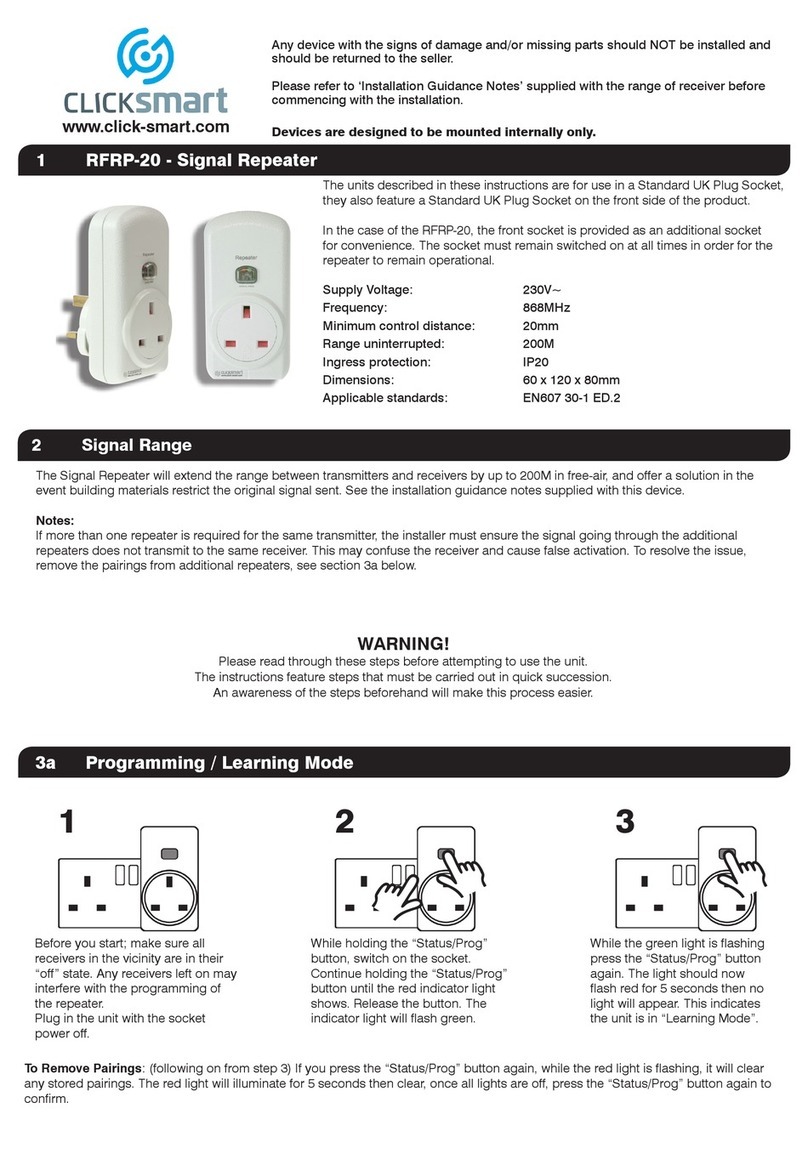
Scolmore
Scolmore RFRP-20 Instruction leaflet

Eminent
Eminent EM4594 Quick installation guide
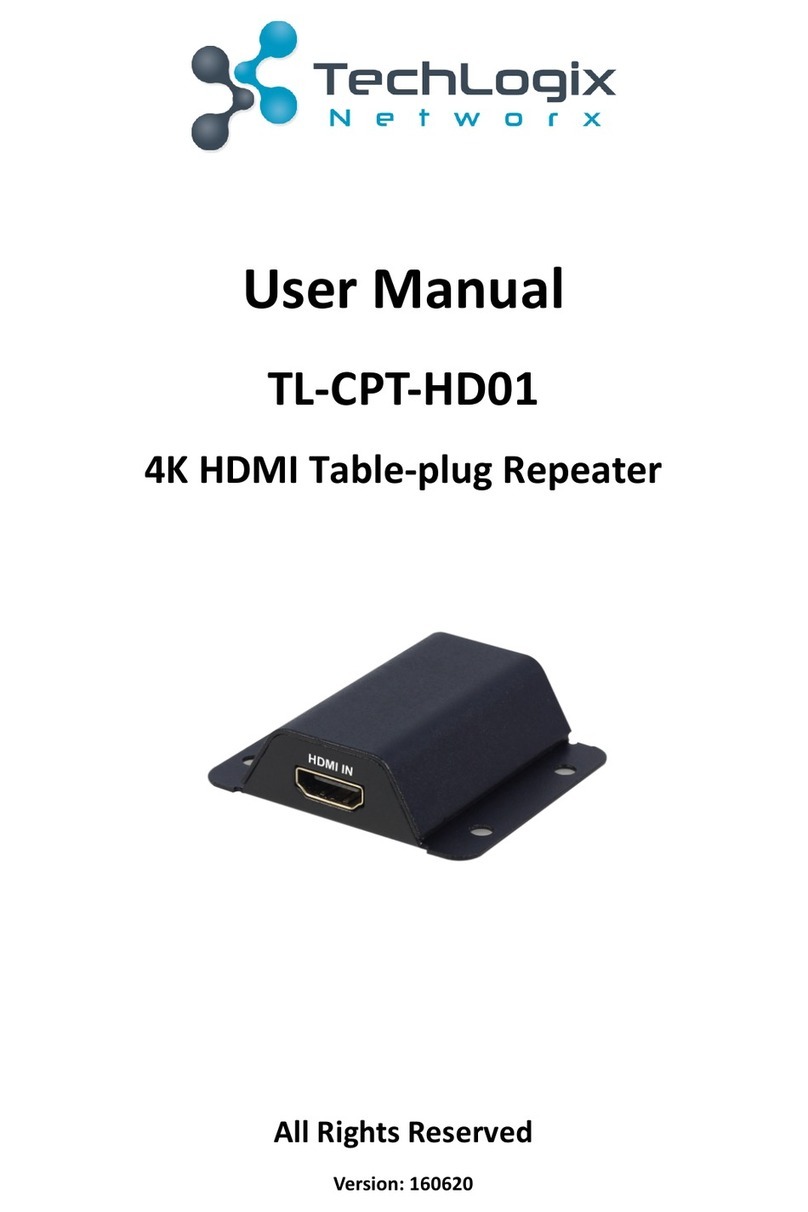
TechLogix Networx
TechLogix Networx TL-CPT-HD01 user manual

Teletek electronics
Teletek electronics TFT Installation & programming manual

COBHAM
COBHAM MBF-40 Americas user manual





